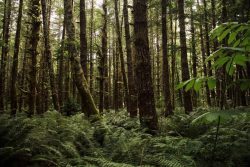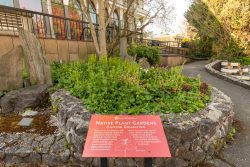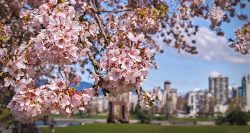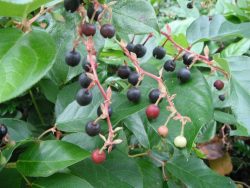The benefits of native plants are often underestimated. What most people don’t know is that native plants are low maintenance and highly sustainable. If you’re considering re-doing your garden this year, here are a few reasons you should consider incorporating native plants.

Red cedar trees and Western sword ferns are extremely common native plants that grow in most forests of coastal BC.
First of all: what are native plants?
Different climates will produce different plants. A plant that loves a hot, arid climate will simply not survive in rainy Vancouver, or even in BC’s interior (which has warm, dry summers, but very cold winters).
The opposite is also true; our rainy coastal weather prevents the growth and proliferation of drought-friendly plants, but a Western red cedar, for example, which relies on heavy rainfall to survive, can thrive unaided.
The term “native plant” refers to any plant or tree that grows in a given microclimate as the result of natural processes. By definition, a native plant is native because it grew and evolved without human aid. Even though a plant that has been introduced to our ecosystem (such as the cherry blossom trees mentioned below) might succeed indefinitely without further human intervention, they are still not considered “native.”

The Royal BC Museum in Victoria, BC has its own garden for native plants.
What’s wrong with non-native/exotic plants?
Often, the tenets of modern landscape design rely heavily on using unique, exotic plants. Vancouver, for example, is famous for its cherry blossom trees (Prunus serrulata), which bring clouds of warm, vibrant spring colour to our streets. However, cherry blossom trees (like many plants around here) are native to Japan, and first came to Vancouver as a gift in the 1930’s before the Park Board began to spread them through the city the following decade.

There’s absolutely nothing wrong with using non-native plants in your garden design. Many landscapes rely on the presence of unusual plants to spice up your garden or landscape, offsetting otherwise consistent greenery. Moreover, some non-native plants are perfectly well-suited to our rainy, temperate climates, and thrive just fine here in Vancouver. Just make sure that the plant you’re getting isn’t noxious or invasive, and make sure that it’s well suited to our warm hardiness zone.
However, there are some benefits to native plants that you might not be aware of:
The Benefits of Native Plants
Though there are many benefits to using native plants, here are the top 5 reasons you should consider it:
1. They’re naturally low-maintenance
Native plants thrive for a reason. They’ve evolved to succeed in their climate, and they’re used to a particular set of soil, drainage, and weather conditions. Therefore, they rarely need supplemental watering, pesticides, or fertilizer, and special care rarely needs to be taken to ensure they survive winter or summer.
2. They’re environmentally friendly
Because native plants require very few extra resources to survive, they conserve water and are naturally more sustainable than non-native or exotic plants. Moreover, native plants don’t need to travel as far to get to you, which means lower transportation emissions.
3. They’re less expensive overall
Because it takes so few resources to maintain native plants, they end up saving you money in the long run.
4. They’re non-invasive
Invasive plants are plant species not naturally found locally that reproduce aggressively and can be hazardous to other plants and wildlife. Native plants are, by definition, non-invasive: there’s no need for a plant to move or migrate when its getting all it needs right where it is, and they won’t compete with other plants for resources like sunlight and water.
5. They attract wildlife and preserve biodiversity
Local plants attract local wildlife. Bees, pollinators, and birds – all of which help preserve and spread plant life – are likely to be attracted to your landscapes, especially in the spring and summer.

Salal (gaultheria shallon) is a very common native plant that grows in BC forests.
Native Plants in British Columbia
Here are some examples of plants that grow naturally in British Columbia:
Trees
- Western Red Cedar (thuja plicata)
- Yellow Cedar (Callitropsis nootkatensis)
- Douglas Fir (Pseudotsuga menziesii)
- Western Hemlock (Tsuga heterophylla)
- Pacific Dogwood (Cornus nuttallii)
- Pacific Madrone (Arbutus menziesii)
- Bigleaf Maple (Acer macrophylla)
- Ponderosa Pine (Pinus ponderosa)
- Vine Maple (Acer circinatum)
Plants/Shrubs/Perennials
- Western Sword Fern (Polystichum munitum)
- Maidenhair Fern (Adiantum pedatum)
- Deer Fern (blechnum spicant)
- Red Osier Dogwood (Cornus stolonifera)
- Salmonberry (Rubus spectabilis)
- Saskatoon Berry (Amelanchier alnifolia)
- Huckleberry (Vaccinium ovatum)
- Salal (Gaultheria shallon)
- Oregon Grape (Mahonia nervosa)
- Pacific Ninebark (Physocarpus capitatus)
- Aster (Aster)
- Coastal Strawberry (Fragaria chiloensis)
- Kinnickinnick (Arctostaphylos uva-ursi)
- Pacific Bleeding Heart (Dicentra formosa)
- Yarrow (Achillea millefolium)
Please note that this is not a full list of BC’s native plants. Also, it’s important to remember that BC is a big province with lots of microclimates – some of these plants only grow naturally in certain areas!
How Can We Help?
Are you sold on the benefits of native plants? Are you now looking to design a more sustainable landscape? Our accredited team of designers and installers would love to hear from you. Get in touch for more information.

Comments are closed here.